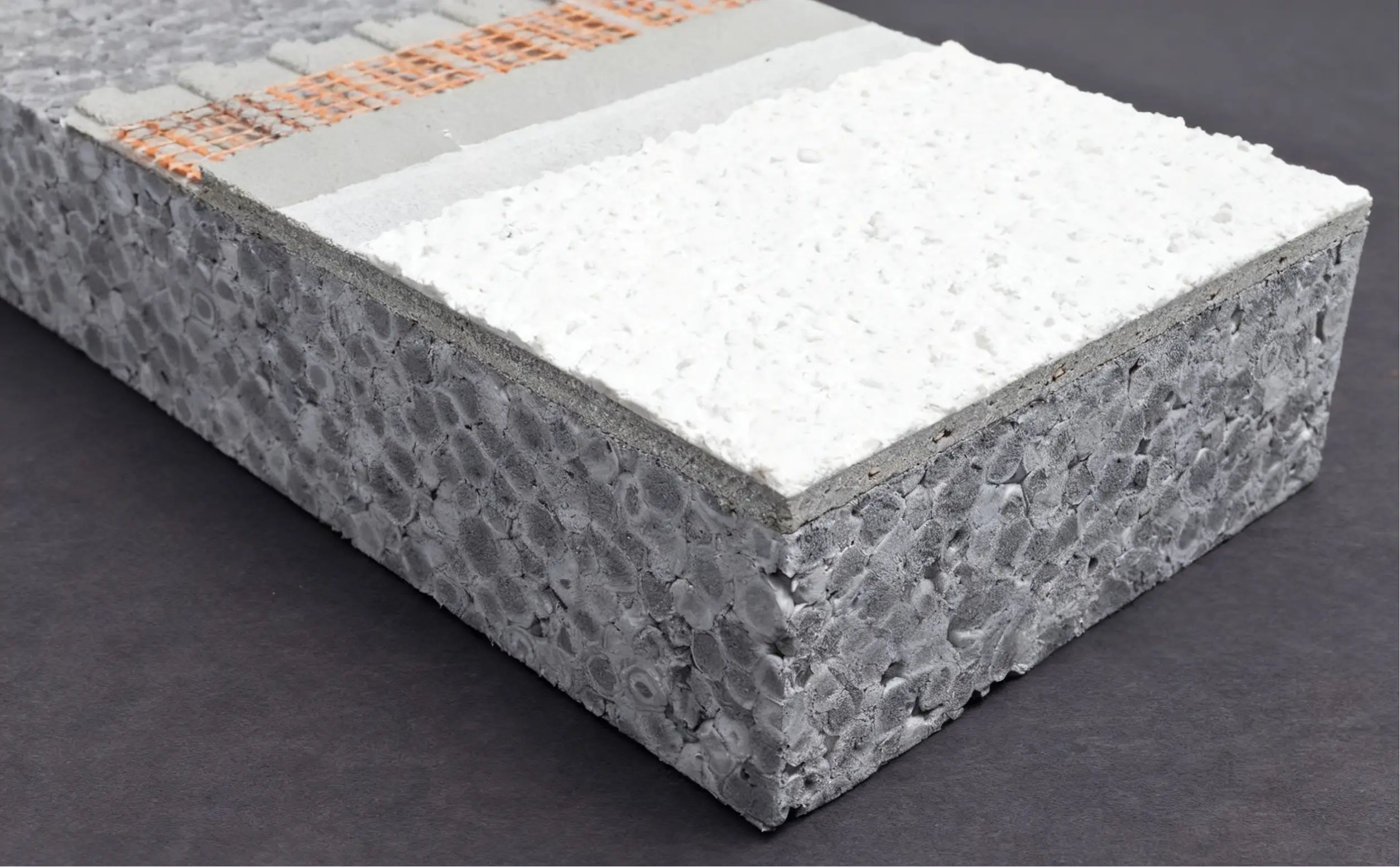
Wondering how polystyrene blocks for construction are shaking up the building world? As a pro in building materials, I’ve watched these light, tough setups push aside old habits. From cutting power bills to fresh building tricks, polystyrene blocks give a complete fix. They mix heat block with support roles. Makers like HUASHENG have boosted this tech. They craft blocks that join strong heat fight, solid build, and quick setup. HUASHENG drives this change with new blocks. These mix great heat work, toughness, and simple handling.
How Has Polystyrene Evolved in the Building Sector?
Polystyrene showed up in the mid-1900s. Folks used it first for packing. It soaked up bumps well and weighed little. But its heat-hold traits caught on in building soon. At the start, people put it as hard foam boards for heat block. Now, its job grew bigger. Builders wanted stuff that was light and saved heat better.
How Did It Transition from Traditional Insulation to Integrated Block Systems?
Old heat block meant stacking foam sheets in wall spots or on tops. Today, ways have changed. Now, polystyrene blocks fit into support setups like Insulated Concrete Forms (ICFs) and Structural Insulated Panels (SIPs). These put heat block right inside the wall or roof frame. So, they stop heat gaps. And they hurry up the setup.
What Role Do Expanded (EPS) and Extruded (XPS) Types Play in Structural Applications?
EPS (Expanded Polystyrene) saves money and shapes easy. It works great for walls that carry no weight, SIP insides, and hole stuff. But XPS (Extruded Polystyrene) differs. It has a shut-cell setup. This brings more push strength and wet fight. So, it fits bases, flat parts, and outside jobs where lasting matters a lot.
What Types and Classifications Define Polystyrene Blocks?
EPS blocks get made by growing beads with steam. This leads to a stuff that lets air through. It suits inside tasks well. XPS blocks come from pushing through a steady step. That builds a shut-cell frame. So, they gain more weight and push power. This makes them top in damp spots like low rooms and under-ground heat block.
What Sets Structural Insulated Panels (SIPs) Apart from Insulated Concrete Forms (ICFs)?
SIPs hold an EPS or XPS middle. It’s stuck between OSB (Oriented Strand Board) or cement boards. They let walls go up fast with few heat crosses. ICFs vary though. They are empty EPS shapes. These act as holds for poured cement. When hard, they bring heat block and weight carry.
How Do They Integrate with Materials Like Concrete and Steel?
Polystyrene blocks for construction get built to mix smooth with rebar nets in strong cement plans. In steel frame jobs, clips fix blocks to frames. They don’t hurt the heat block. Mixed setups win from linking polystyrene heat block with support frames. This leads to best tough-light balance.
What Thermal Performance Advantages Do Polystyrene Blocks Offer?
Both EPS and XPS grab air in their cell frames. Air passes heat poorly. So, this cuts heat shift through the stuff. XPS often brings lower heat pass. Its cell frame stays even. And it weighs more.
What Influences Thermal Resistance (R-Value) in EPS and XPS?
The R-value climbs with stuff weight and thick. Take high-weight XPS. It can hit R-values of 5 per inch or higher. Tiny cell sizes cut swirl move inside too. This lifts work in mixed weather.
How Do They Compare to Mineral Wool, Polyurethane Foam, and Fiberglass?
Polystyrene brings close R-values at cheap fix costs next to mineral wool. Unlike fiberglass, EPS/XPS fight wet. They hold heat value when damp. Polyurethane foam can bring higher R-values in slim parts. Yet, it asks more cash. And it’s less kind to nature.
How Do Energy Efficiency Benefits Enhance Building Envelopes?
Polystyrene block setups bring full heat block. They cover the frame without holes at posts or meets. This stops heat bridges. Those let warmth slip in old frame walls.
What Role Do Interlocking Designs Play in Air Tightness and Vapor Control?
Cut-sharp lock shapes build close edges. They cut air slip. XPS wet spread fight aids too. It holds damp shift through wall bits. This blocks wet pile and mold.
How Do Seasonal Energy Savings Vary in Different Climates?
In cold spots, polystyrene blocks keep inner warmth. This drops heat needs big time. In warm areas, they bounce outer heat adds. So, they cut cool asks. This aids power save through the year.
What High-Performance Solutions Exist for Polystyrene Blocks?

New mixes add graphite to EPS. This boosts R-values. They use reused bits to cut nature hit. Makers like HUASHENG build double-weight insides too. These link tough with heat save.
What Performance Metrics Matter: R-Values, Compressive Strength, Fire Resistance?
Top polystyrene blocks show R-values up to 5 per inch for XPS. Push strengths top 25 psi. Flame-slow adds meet hard safety rules like ASTM E84 and EN 13501 groups.
Which Product Lines Suit Residential, Commercial, and Passive House Standards?
EcoBlock™ series hits cheap home jobs with good heat block. Structura™ ICF Systems bring work-level tough. ThermoCore™ XPS Blocks give top work for Passive House-ok builds.
How Do These Blocks Integrate with Modern Systems and Codes?
Polystyrene block setups get shaped to hit world rules. Like ASHRAE 90.1 for power save in U.S. builds. IECC 2021 build rules. And the EU’s Energy Performance of Buildings Directive (EPBD).
How Do They Support LEED and BREEAM Certifications?
These setups add to LEED power save points through high R-values. Many goods hold reused bits or can reuse. This backs BREEAM’s trash cut rules.
How Compatible Are They with Sustainable Practices?
Polystyrene blocks cut run power. They shrink heat/cool needs. This eases net-zero aims through green adds like solar PV.
How Does Lifecycle Assessment Balance Embodied Carbon and Savings?
Start make ties to fuel-based inputs. Yet, long power saves top built-in carbon over build life. This often hits in 5 years of run.
What Structural Capabilities Extend Beyond Insulation?
ICFs use polystyrene shapes as cement holds. They back frame loads while it sets. Filled with strong cement, they spread loads even over walls. This drops stress bunches.
What Enhances Seismic Resilience and Wind-Load Resistance?
Setups with rebar through polystyrene insides let flex under shake loads. Thick foam frames stuck to cement hold high wind push without peel.
How Do Fire Safety Considerations Factor into Block Design?
In make, fire slow bits like HBCD swaps mix straight into the base mix. This makes sure steady flame fight through the block bulk.
What Fire Rating Classifications Apply Under Standards?
EPS/XPS blocks can grab Class B under EN 13501. Or hit ASTM E84 asks for low flame stretch and smoke build. This counts for rule ok in used builds.
What Installation Techniques Deliver On-Site Benefits?
Polystyrene blocks weigh far less than stone or CMU bits. This lets one person handle on spot. Lock shapes snap quick without mud or stick. This speeds wall build.
How Does Reduction in Material Waste Occur During Installation?
Blocks arrive pre-slice or size-fit to shrink cut on spot. Extra scrap can get picked for new stuff or use as stuff-in.
What Ensures Long-Term Durability and Low Maintenance?
Shut-cell frames fight water grab. Chem inert, they skip mold grow or bug draw. This fits damp low spots or hot areas.
What Supports Longevity in Varying Climates?
Guard coats shield bare polystyrene from UV break. Work checks over hard Asia-Pacific weather prove size hold from -30°C to +50°C spots.
How Does Economic Evaluation Favor Developers and Contractors?
Start costs can beat fiberglass heat block or stone build. Yet, shrunk HVAC loads bring 20–30% less power bills each year. This gets back cash in five years.
How Does Superior Insulation Reduce HVAC Sizing?
By hitting tighter heat wraps, small HVAC bits work. This trims cash costs in MEP plan bits. While it drops run spends through stay.
What Government Incentives Promote Advanced Insulation?
Many spots give tax cuts or cash back linked to power-save ok. When using top heat stuff like EPS/XPS blocks. This lifts ROI more.
What Recommendations Guide Implementation?
Job scale, weather zone, load asks, and plan aim guide pick. Home spots win from light EPS. Work or mid-rise builds ask strong ICFs. Net-zero jobs need super-low pass XPS setups.
What Works for Residential Low-Rise Applications?
Opt for EcoBlock™ EPS Panels – they deliver affordable thermal comfort.
What Suits Mid-Rise Commercial Buildings?
Choose Structura™ ICF Systems for strength plus insulation.
What Fits Passive House or Net Zero Projects?
Select ThermoCore™ XPS Blocks for minimal heat loss.
What Best Practices Maximize Thermal Performance?
Early team with builders makes sure right bits around windows, joins, and shifts. This skips heat cross. While it eases permit ok.
What On-Site Guidelines Ensure Execution?
Fix folks should learn handle steps. To skip cell crush or air seal harm. Spot checks prove air tight through blow-door tests. Before outside fix.
FAQs
Q: How do polystyrene blocks compare cost-wise to traditional insulation?
A: They often cost more upfront but save 20–30% on energy bills long-term, with quick ROI.
Q: Are these blocks suitable for earthquake-prone areas?
A: Yes, when reinforced with rebar, they enhance seismic resilience through flexible integration.
Q: What maintenance do polystyrene blocks require?
A: Minimal—their resistance to moisture and pests means rare inspections suffice.






